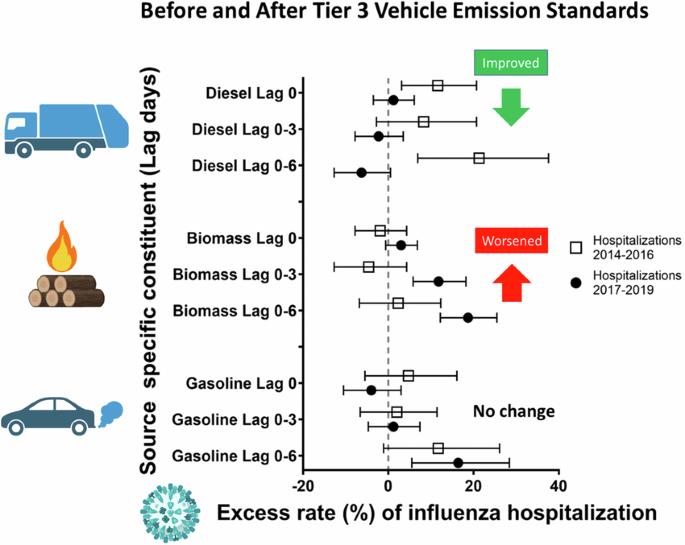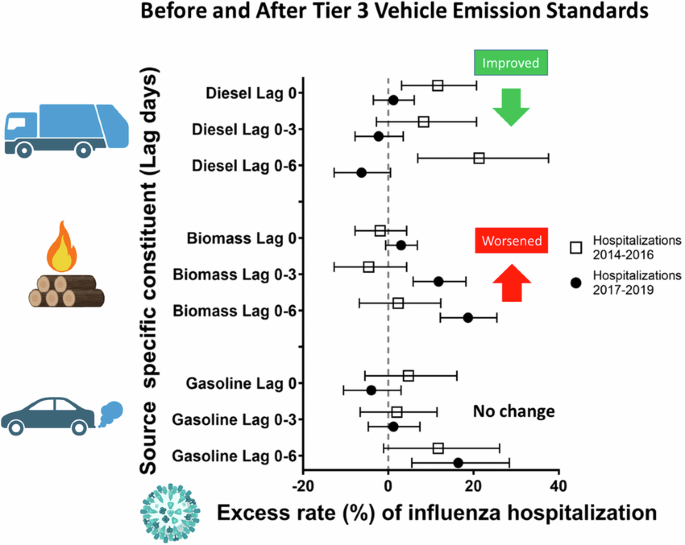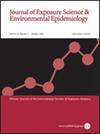纽约州第三级车辆标准实施前后特定来源 PM2.5 导致的流感就诊率比较。
IF 4.7
3区 医学
Q2 ENVIRONMENTAL SCIENCES
Journal of Exposure Science and Environmental Epidemiology
Pub Date : 2024-08-10
DOI:10.1038/s41370-024-00710-w
引用次数: 0
摘要
背景:与特定来源的 PM2.5 相关的成人流感就诊率是一个正在积极研究的领域:在 2017 年立法要求减少轻型汽车尾气排放之后,我们假设在该法规实施初期(2017-2019 年),流感就诊率的降低与交通来源 PM2.5 的浓度有关:我们利用全州规划与研究合作系统(SPARCS)对纽约州因流感住院(5328 人)或在急诊科接受治疗(18247 人)的成年患者进行了研究。我们采用改良的病例交叉设计,估算了流感住院和急诊就诊的超额率(ER)与滞后日 0、0-3 和 0-6 的特定来源 PM2.5 浓度(如火花点火排放 [GAS]、生物质燃烧 [BB]、柴油 [DIE])的四分位数区间增加有关。然后,我们评估了第 3 级实施后(2017-2019 年)的 ER 与实施前(2014-2016 年)相比是否有所不同:在 2014-2016 年期间,滞后天数 0-6 的 DIE 每增加一个四分位数间距,流感住院率就会增加 21.3%(95% CI:6.9,37.6),而在 2017-2019 年期间,流感住院率则会降低 6.3%(95% CI:-12.7,0.5)。就急诊就诊而言,2017-2019 年期间的 GAS/流感超额率大于 2014-2016 年期间。与 2014-2016 年期间相比,我们还观察到 2017-2019 年期间与 BB 增加相关的急诊室更大:我们介绍了一项关于第三级汽车排放标准早期实施期对纽约州特定 PM2.5 空气污染源与流感医疗就诊之间关联的影响的问责研究。我们发现,汽油排放与流感就诊率之间的联系在不同时期并没有减弱,这可能是因为排放标准尚未完全实施。与柴油排放相关的流感就诊率的降低可能反映了过去降低柴油排放毒性的政策。责任研究可以帮助政策制定者和环境科学家更好地了解污染变化的时间和相关的健康影响。本文章由计算机程序翻译,如有差异,请以英文原文为准。


Comparison of the rate of healthcare encounters for influenza from source-specific PM2.5 before and after tier 3 vehicle standards in New York state
Influenza healthcare encounters in adults associated with specific sources of PM2.5 is an area of active research. Following 2017 legislation requiring reductions in emissions from light-duty vehicles, we hypothesized a reduced rate of influenza healthcare encounters would be associated with concentrations of PM2.5 from traffic sources in the early implementation period of this regulation (2017–2019). We used the Statewide Planning and Research Cooperative System (SPARCS) to study adult patients hospitalized (N = 5328) or treated in the emergency department (N = 18,247) for influenza in New York State. Using a modified case-crossover design, we estimated the excess rate (ER) of influenza hospitalizations and emergency department visits associated with interquartile range increases in source-specific PM2.5 concentrations (e.g., spark-ignition emissions [GAS], biomass burning [BB], diesel [DIE]) in lag day(s) 0, 0–3 and 0–6. We then evaluated whether ERs differed after Tier 3 implementation (2017–2019) compared to the period prior to implementation (2014–2016). Each interquartile range increase in DIE in lag days 0–6 was associated with a 21.3% increased rate of influenza hospitalization (95% CI: 6.9, 37.6) in the 2014–2016 period, and a 6.3% decreased rate (95% CI: −12.7, 0.5) in the 2017–2019 period. The GAS/influenza excess rates were larger in the 2017–2019 period than the 2014–2016 period for emergency department visits. We also observed a larger ER associated with increased BB in the 2017–2019 period compared to the 2014–2016 period. We present an accountability study on the impact of the early implementation period of the Tier 3 vehicle emission standards on the association between specific sources of PM2.5 air pollution on influenza healthcare encounters in New York State. We found that the association between gasoline emissions and influenza healthcare encounters did not lessen in magnitude between periods, possibly because the emissions standards were not yet fully implemented. The reduction in the rates of influenza healthcare encounters associated with diesel emissions may be reflective of past policies to reduce the toxicity of diesel emissions. Accountability studies can help policy makers and environmental scientists better understand the timing of pollution changes and associated health effects.
求助全文
通过发布文献求助,成功后即可免费获取论文全文。
去求助
来源期刊
CiteScore
8.90
自引率
6.70%
发文量
93
审稿时长
3 months
期刊介绍:
Journal of Exposure Science and Environmental Epidemiology (JESEE) aims to be the premier and authoritative source of information on advances in exposure science for professionals in a wide range of environmental and public health disciplines.
JESEE publishes original peer-reviewed research presenting significant advances in exposure science and exposure analysis, including development and application of the latest technologies for measuring exposures, and innovative computational approaches for translating novel data streams to characterize and predict exposures. The types of papers published in the research section of JESEE are original research articles, translation studies, and correspondence. Reported results should further understanding of the relationship between environmental exposure and human health, describe evaluated novel exposure science tools, or demonstrate potential of exposure science to enable decisions and actions that promote and protect human health.

 求助内容:
求助内容: 应助结果提醒方式:
应助结果提醒方式:


